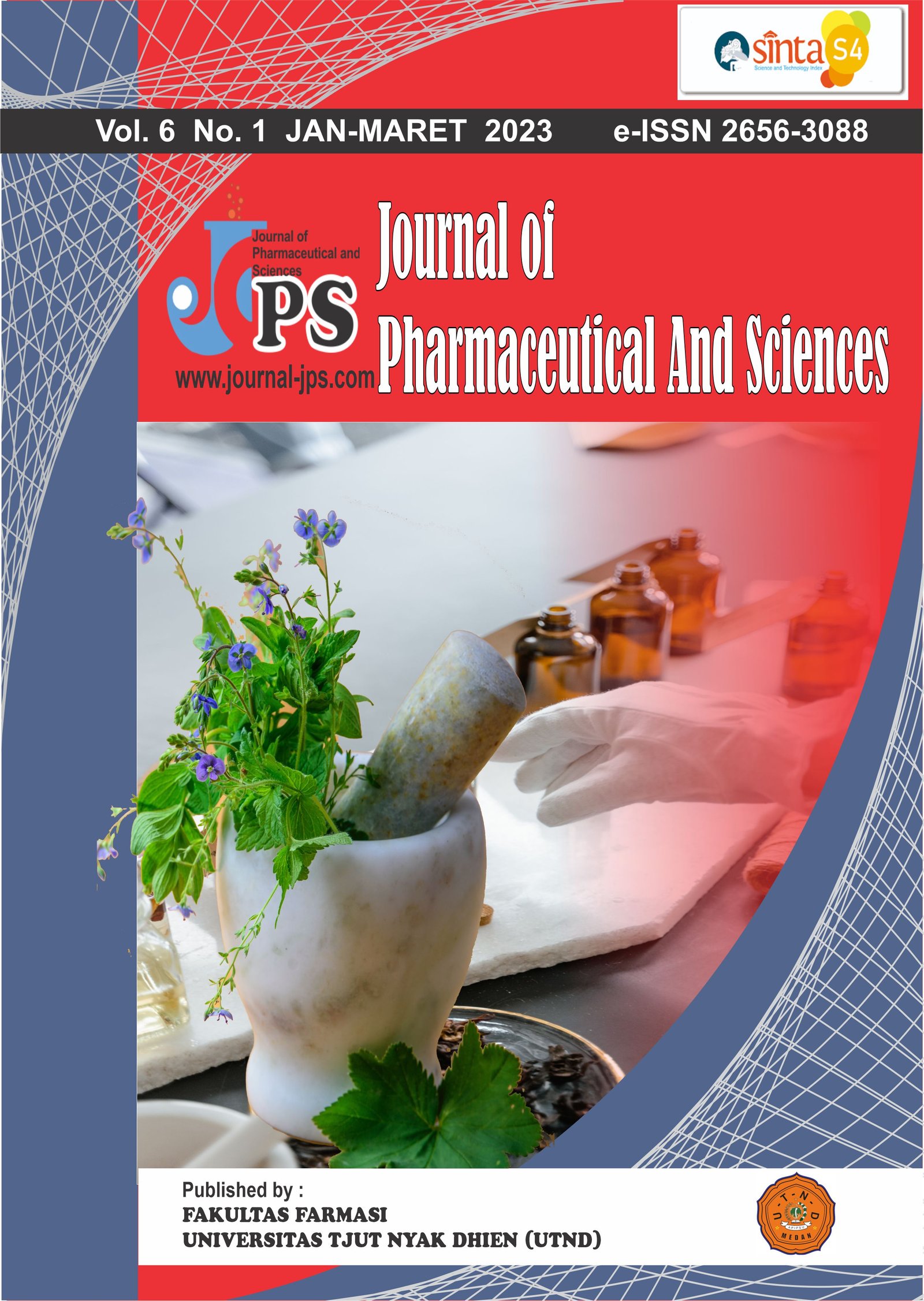Artikel Review: Tinjauan Pemilihan Obat Antipiretik untuk Anak-Anak
Isi Artikel Utama
Page: 230-236
Abstrak
Ketika berada dalam kesehatan fisik yang baik, manusia dapat dengan mudah melakukan berbagai aktivitas. Namun ada kalanya tubuh tidak dapat beraktivitas seperti biasa dikarnakan tubuh terpapar penyakit yang biasanya diawali dengan adanya gejala-gejala yang dapat dirasakan. Demam merupakan gejala dari timbulnya penyakit dengan meningkatnya suhu tubuh diatas normal (>38°C). Untuk mengatasi demam yang terjadi pada anak, dapat dilakukan terapi farmakologi maupun non farmakologi. Terapi farmakologi yaitu dengan memberikan obat penurun demam. Obat demam yang sering digunakan yaitu golongan antipiretik, contohnya adalah parasetamol atau ibuprofen. Penelitian ini bertujuan untuk mengkaji obat antipiretik apakah yang paling sering dipilih untuk pengobatan demam pada anak-anak. Metode dalam studi ini adalah systematic review yang ditelusuri melalui Google Scholar dan PubMed dengan rentang terbit 10 tahun yaitu terbitan tahun 2012 hingga 2022. Hasil penelitian ini menunjukan bahwa paracetamol dan ibuprofen memang menjadi pilihan pertama untuk pengobatan demam pada anak. Pada pemilihan penggunaan antipiretik ini masih berimbang antara paracetamol atau ibuprofen, hal tersebut dipengaruhi oleh faktor pengetahuan, mulai dari informasi yang didapat melalui pencarian pribadi, informasi dari kerabat maupun dari resep dokter yang pernah diterima.
Unduhan
Rincian Artikel

Artikel ini berlisensiCreative Commons Attribution-NonCommercial-ShareAlike 4.0 International License.
Referensi
Artemisia, S. (2022). Hubungan Profil Masyarakat di Wilayah Kerja Puskesmas Sobo terhadap Penanganan Demam dan Pola Swamedikasi Obat Antipiretik pada Balita. Professional Health Journal, 3(2), 61–66.
Aryanti Wardiyah, Setiawati Setiawati, & Dwi Setiawan. (2016). Perbandingan Efektifitas Pemberian Kompres Hangat dan Tepidsponge Terhadap Penurunan Suhu Tubuh Anak yang Mengalamidemam RSUD Dr. H. Abdul Moeloek Provinsi Lampung. Journal of Nursing Science Update (JNSU), 4(1), 44–56.
Bachtiar, A., & Hapsari, D. (2022). Profil Penggunaan Analgetik Antipiretik pada Resep Pasien Anak di Puskesmas Gegesik Kabupaten Cirebon. Medimuh: Jurnal Kesehatan Muhammadiyah, 3(1), 5–10.
Banks, T., Paul, S. P., & Wall, M. (2013). Managing Fever in Children With a Single Antipyretic. Nursing Times, 109(7), 24–25.
Bhat, A., Mushtaq, S., Mohammad, F., Khan, S., Akther, R., Bhat, I., & Jahangir, S. (2017). Effective Antipyretic in Children: Paracetamol V/S Ibuprofen and Combination Therapy. World Journal of Pharmaceutical and Medical Research, 3(11), 70–72.
Castellano, V., Talamona, N., Giglio, N., Sabbaj, L., & Gentile, A. (2020). Knowledge and management of fever in parents of children under 5 years of age at a children's hospital. Arch Argent Pediatr, 118(2), 89–94.
de Martino, M., & Chiarugi, A. (2015). Recent Advances in Pediatric Use of Oral Paracetamol in FeveraAnd Pain Management. Pain And Therapy, 4(2), 149–168.
Efayanti, E., Susilowati, T., & Imamah, I. (2019). Hubungan Motivasi dengan Perilaku Swamedikasi. Jurnal Penelitian Perawat Profesional, 1(1), 21–32.
M. Saito. (2013). Mukjizat Suhu Tubuh. Gramedia Pustaka Utama.
Mackowiak, P. (1998). Concepts of Fever. Archives of Internal Medicine, 158(17), 1870–1881.
Manan, E. (2014). Buku Pintar Swamedikasi. Saufa.
National Collaborating Centre for Women's and Children's Health (UK). (2013). Feverish illness in children: assessment and initial management in children younger than 5 years. Royal College of Obstetricians and Gynaecologists (UK).
Neal, M. (2006). At Glance Farmakologi Medis Edisi 5. Erlangga.
Pereira, G., Tavares, N., Mengua, S., & Dal Pizzol, T. (2013). Therapeutic procedures and use of alternating antipyretic drugs for fever management in children. Jornal de Pediatria, 89, 25–32.
Rafila, R., & Miyarso, C. (2018). Tingkat Pengetahuan Swamedikasi Dalam Penanganan Demam Pada Anak Oleh Ibu Di Rw 5 Dusun Sidoharum Sempor Kebumen. Jurnal Ilmiah Kesehatan Keperawatan, 14(1).
Section on Clinical Pharmacology, Committee on Drugs, Sullivan, J. E., & Farrar, H. C. (2011). Fever and antipyretic use in children. In Pediatrics (Vol. 127, Issue 3, pp. 580–587). https://doi.org/10.1542/peds.2010-3852
Soedarmo, S., Garna, H., Hadinegoro, S., & Satari, H. (2008). Buku Ajar Infeksi dan Pediatri Tropis Edisi Kedua. Badan Penelitian IDAI.
Soedibyo, S., & Souvriyanti, E. (2016). Gambaran Persepsi Orang Tua tentang Penggunaan Antipiretik sebagai Obat Demam. Sari Pediatri, 8(2), 142–146.
Surya, M., Artini, G., & Ernawati, D. (2018). Pola Penggunaan Parasetamol atau Ibuprofen sebagai Obat Antipiretik Single Therapy pada Pasien Anak. E-Jurnal Medika, 7(8), 1–13.
Temple, A., Temple, B., & Kuffner, E. (2013). Dosing and Antipyretic Efficacy of Oral Acetaminophen in Children. Clinical Therapeutics, 35(9), 1361–1375.
Tjay, T. H., & Rahardja, K. (2007). Obat-Obat Penting: Khasiat, Penggunaan dan Efek-Efek Sampingnya. Elex Media Komputindo.
Yavuz, E., Yayla, E., Cebeci, S., Kirimli, E., Gumustakim, R., Cakir, L., & Dogan, S. (2017). Parental beliefs and practices regarding childhood fever in Turkish primary care. Nigerian Journal of Clinical Practice, 20(1), 93–98.





